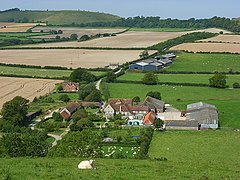Maiden Bradley
| Maiden Bradley | |
|---|---|
 The south-east of the parish forms this projection, of Rodmead Farm and Rodmead Hill. |
|
 The south of the parish including the Long Knoll, a marilyn and Little Knoll (background) |
|
| Maiden Bradley shown within Wiltshire | |
| Area | 18.62 km2 (7.19 sq mi) |
| Population | 331 (2011 census) |
| • Density | 18/km2 (47/sq mi) |
| OS grid reference | ST802389 |
| Civil parish |
|
| Unitary authority | |
| Ceremonial county | |
| Region | |
| Country | England |
| Sovereign state | United Kingdom |
| Post town | Warminster |
| Postcode district | BA12 7H |
| Dialling code | 01985 |
| Police | Wiltshire |
| Fire | Dorset and Wiltshire |
| Ambulance | South Western |
| EU Parliament | South West England |
| UK Parliament | |
| Website | Parish Council |
Maiden Bradley is a village in southwest Wiltshire, England, about 6 miles (10 km) southwest of Warminster and bordering the county of Somerset. The B3092 road between Frome and Mere forms the village street. Bradley House, the seat of the Duke of Somerset, is adjacent to the village.
Maiden Bradley is the principal settlement in the civil parish of Maiden Bradley with Yarnfield. The parish is in the Cranborne Chase and West Wiltshire Downs Area of Outstanding Natural Beauty and was one of the clearings in the former Selwood Forest. In the northwest the parish includes the hamlet of Gare Hill, although most dwellings there are in Trudoxhill parish, Somerset.
The village takes its name from the leper hospital for maidens founded in the 12th century. Bradley means a wide clearing or wood; Brad = Broad (OE) & Ley = clearing (OE). 1½ miles southwest of the village is the deserted medieval village, now farming hamlet, of Yarnfield. Formerly in the county of Somerset, Yarnfield was transferred to Wiltshire in 1895.
The earliest reference to the village is a Saxon land charter of 878, but the community's origins can be traced back thousands of years. There are numerous tumuli including a Bronze Age barrow opened by Richard Colt Hoare in 1807. It contained a complete skeleton accompanied by numerous items, three of which are on display in the Wiltshire Heritage Museum at Devizes. Other finds include an Iron Age gold coin, Roman remains and a Saxon barrow.
...
Wikipedia

